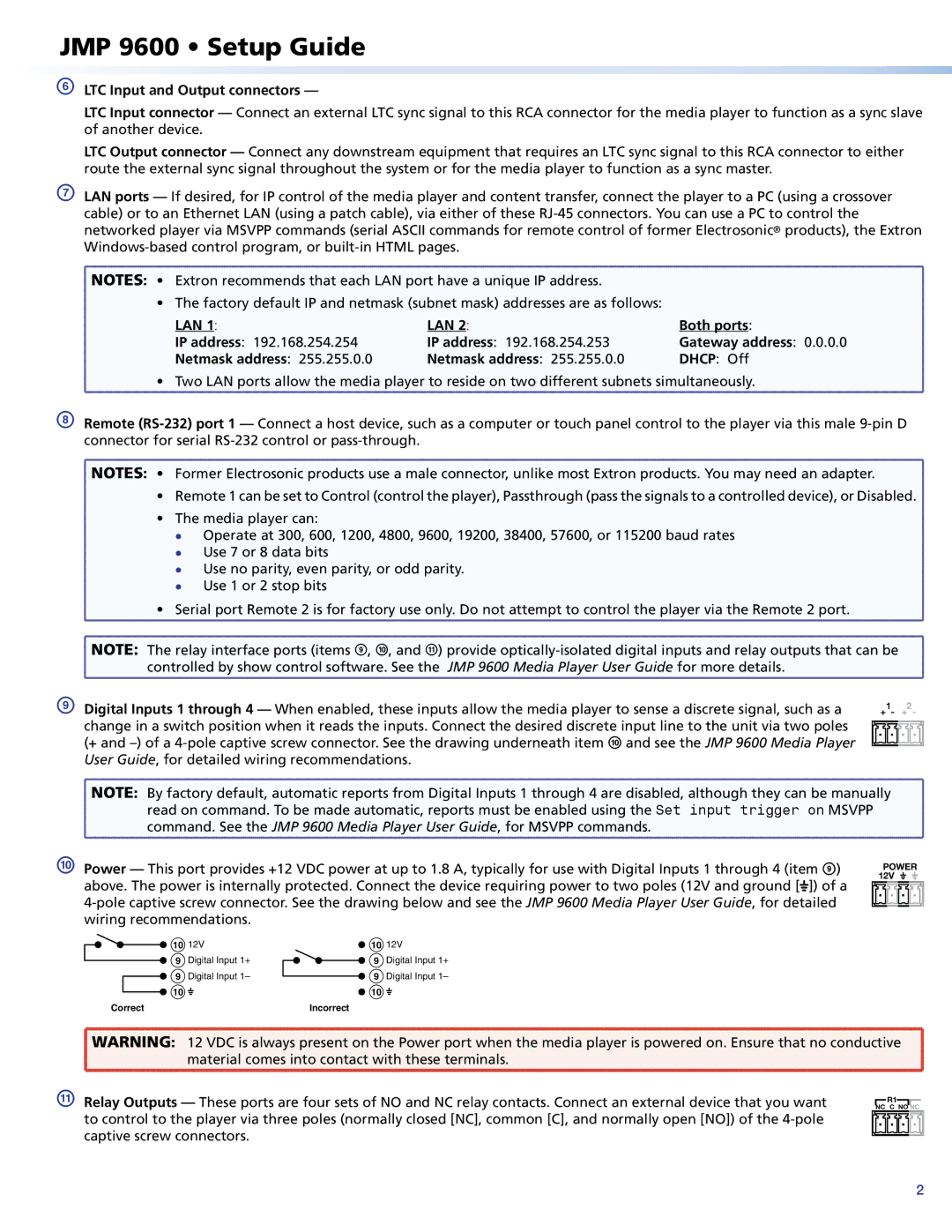
JMP 9600 • Setup Guide
fLTC Input and Output connectors —
LTC Input connector — Connect an external LTC sync signal to this RCA connector for the media player to function as a sync slave of another device.
LTC Output connector — Connect any downstream equipment that requires an LTC sync signal to this RCA connector to either route the external sync signal throughout the system or for the media player to function as a sync master.
gLAN ports — If desired, for IP control of the media player and content transfer, connect the player to a PC (using a crossover cable) or to an Ethernet LAN (using a patch cable), via either of these
![]() NOTES: • Extron recommends that each LAN port have a unique IP address.
NOTES: • Extron recommends that each LAN port have a unique IP address.
• The factory default IP and netmask (subnet mask) addresses are as follows:
LAN 1: | LAN 2: | Both ports: |
IP address: 192.168.254.254 | IP address: 192.168.254.253 | Gateway address: 0.0.0.0 |
Netmask address: 255.255.0.0 | Netmask address: 255.255.0.0 | DHCP: Off |
• Two LAN ports allow the media player to reside on two different subnets simultaneously.
hRemote
![]() NOTES: • Former Electrosonic products use a male connector, unlike most Extron products. You may need an adapter.
NOTES: • Former Electrosonic products use a male connector, unlike most Extron products. You may need an adapter.
• Remote 1 can be set to Control (control the player), Passthrough (pass the signals to a controlled device), or Disabled. ![]()
• The media player can:
zz Operate at 300, 600, 1200, 4800, 9600, 19200, 38400, 57600, or 115200 baud rates
zz Use 7 or 8 data bits
zz Use no parity, even parity, or odd parity.
zz Use 1 or 2 stop bits
• Serial port Remote 2 is for factory use only. Do not attempt to control the player via the Remote 2 port.
![]() NOTE: The relay interface ports (items i, j, and k) provide
NOTE: The relay interface ports (items i, j, and k) provide ![]() controlled by show control software. See the JMP 9600 Media Player User Guide for more details.
controlled by show control software. See the JMP 9600 Media Player User Guide for more details.
iDigital Inputs 1 through 4 — When enabled, these inputs allow the media player to sense a discrete signal, such as a change in a switch position when it reads the inputs. Connect the desired discrete input line to the unit via two poles (+ and
+1- +2 -
![]() NOTE: By factory default, automatic reports from Digital Inputs 1 through 4 are disabled, although they can be manually
NOTE: By factory default, automatic reports from Digital Inputs 1 through 4 are disabled, although they can be manually
read on command. To be made automatic, reports must be enabled using the Set input trigger on MSVPP command. See the JMP 9600 Media Player User Guide, for MSVPP commands.
jPower — This port provides +12 VDC power at up to 1.8 A, typically for use with Digital Inputs 1 through 4 (item i) above. The power is internally protected. Connect the device requiring power to two poles (12V and ground [![]() ]) of a
]) of a
10 | 12V | 10 | 12V |
9 | Digital Input 1+ | 9 | Digital Input 1+ |
9 | Digital Input 1– | 9 | Digital Input 1– |
10 |
| 10 |
|
Correct |
| Incorrect |
|
POWER 12V ![]()
![]()
![]() WARNING: 12 VDC is always present on the Power port when the media player is powered on. Ensure that no conductive
WARNING: 12 VDC is always present on the Power port when the media player is powered on. Ensure that no conductive ![]() material comes into contact with these terminals.
material comes into contact with these terminals.
kRelay Outputs — These ports are four sets of NO and NC relay contacts. Connect an external device that you want to control to the player via three poles (normally closed [NC], common [C], and normally open [NO]) of the
R1
NC C NO NC
2
